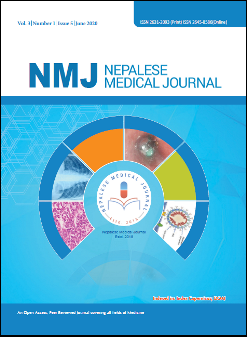Detection of Hemoglobinopathies by HPLC in a Referral Clinical Laboratory in Nepal
DOI:
https://doi.org/10.3126/nmj.v3i1.29477Keywords:
Hemoglobinopathies, HPLC, Nepal, ThalassemiaAbstract
Introduction: Various hemoglobin variants are prevalent in the Nepalese population owing to the ethnic diversity of our population. Detection of asymptomatic carriers by a reliable laboratory method is the cornerstone of prevention of this serious health problem. The simplicity of the automated system with internal sample preparation, superior resolution, rapid assay time, and accurate quantification of hemoglobin fractions makes ion-exchange high-performance liquid chromatography (IEX- HPLC) an ideal methodology for the routine screening for hemoglobinopathies. We report the clinical laboratory-based prevalence of variant hemoglobin and hemoglobinopathies through IEX- HPLC analysis in a cohort of patients referred for hemoglobin electrophoresis to a referral clinical laboratory in Nepal.
Materials and Methods: The variant hemoglobin and hemoglobinopathy were diagnosed based on percentage, retention time, and peak characteristics of variant hemoglobin in a chromatogram. Peripheral blood films, reticulocyte count, serum iron profile, and sickling test were done in selected cases along with detailed family history.
Results: Hemoglobinopathy was detected in all age group but the vast majority was detected between 20 to 40 years of age. Beta thalassemia trait was the most frequently detected hemoglobinopathy in all age groups.
Conclusions: The present study conducted using IEX-HPLC reflects the magnitude of thalassemia and hemoglobinopathies in a laboratory-based population which helps to increase awareness among both health caregivers and the general population. Routine screening for hemoglobinopathy of individuals at the reproductive age group is recommended and this screening can be done through IEX-HPLC.
Downloads
Downloads
Published
How to Cite
Issue
Section
License
This license enables reusers to distribute, remix, adapt, and build upon the material in any medium or format, so long as attribution is given to the creator. The license allows for commercial use.
Copyright on any article published by Nepalese Medical Journal is retained by the author(s).
Authors grant Nepalese Medical Journal a license to publish the article and identify itself as the original publisher.
Authors also grant any third party the right to use the article freely as long as its integrity is maintained and its original authors, citation details and publisher are identified.




